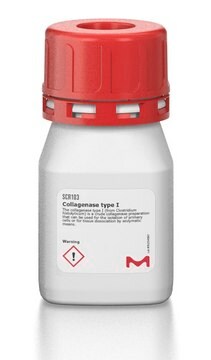1148090
USP
Collagénase from Clostridium histolyticum
United States Pharmacopeia (USP) Reference Standard
Synonyme(s) :
Clostridiopeptidase A
About This Item
Produits recommandés
Qualité
pharmaceutical primary standard
Fabricant/nom de marque
USP
Application(s)
pharmaceutical
Format
neat
Température de stockage
−70°C
Vous recherchez des produits similaires ? Visite Guide de comparaison des produits
Description générale
Application
- Collagenase Type II for Enhanced Cell Isolation in Biomedical Research: Collagenase Type II is extensively applied in tissue dissociation for isolating cells, crucial for regenerative medicine and tissue engineering. It enables efficient breakdown of the extracellular matrix, facilitating easier cell extraction and purification for use in 3D cell culture and stem cell research. This enzymatic method is invaluable for studies requiring high-purity cell populations, making it indispensable in developing therapies for diseases like Parkinson′s and Alzheimer′s (Park et al., 2024).
- Advancing Tissue Engineering with Collagenase II: In tissue engineering, Collagenase II plays a pivotal role by degrading the collagen matrix in tissues, thereby enabling the cultivation of cells in a controlled environment. This process is essential for constructing tissue structures from the ground up, particularly in developing organoids that mimic natural organ functionalities. The use of high-grade biotech collagenase ensures reproducibility and effectiveness in these sophisticated applications (Wu et al., 2024).
- Collagenase II in 3D Cell Culture Systems: Collagenase II is instrumental in preparing extracellular matrices for 3D cell cultures, which are critical for studying cell behaviors in environments that closely replicate in vivo conditions. This enzyme helps in the accurate study of cellular interactions and pharmacological responses, providing a more realistic assessment of cellular dynamics in medical research (Jiang et al., 2024).
- Role of Collagenase II in Stem Cell Research: Utilizing Collagenase II in stem cell research enhances the isolation and maintenance of stem cells. This is particularly important for applications where the integrity and viability of stem cells are crucial, such as in regenerative medicine and therapeutic cloning. The enzyme′s ability to gently dissociate cells while preserving their functionality makes it a staple in cutting-edge biomedical research (Simón-Pérez et al., 2024).
- Collagenase II for Effective Extracellular Matrix Degradation: The ability of Collagenase II to efficiently degrade collagen-rich extracellular matrices is utilized in various biomedical applications, including cancer research where it aids in tumor microenvironment studies and drug penetration analyses. This enzymatic activity is crucial for understanding the interactions between cancer cells and their surrounding stroma, providing insights into potential therapeutic targets (Mohamed et al., 2024).
Actions biochimiques/physiologiques
Définition de l'unité
Remarque sur l'analyse
Autres remarques
Mention d'avertissement
Danger
Mentions de danger
Conseils de prudence
Classification des risques
Resp. Sens. 1
Code de la classe de stockage
12 - Non Combustible Liquids
Classe de danger pour l'eau (WGK)
WGK 1
Point d'éclair (°F)
Not applicable
Point d'éclair (°C)
Not applicable
Faites votre choix parmi les versions les plus récentes :
Certificats d'analyse (COA)
It looks like we've run into a problem, but you can still download Certificates of Analysis from our Documents section.
Si vous avez besoin d'assistance, veuillez contacter Service Clients
Déjà en possession de ce produit ?
Retrouvez la documentation relative aux produits que vous avez récemment achetés dans la Bibliothèque de documents.
Les clients ont également consulté
Notre équipe de scientifiques dispose d'une expérience dans tous les secteurs de la recherche, notamment en sciences de la vie, science des matériaux, synthèse chimique, chromatographie, analyse et dans de nombreux autres domaines..
Contacter notre Service technique








